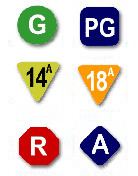 | ||
Motion picture ratings in Canada are mostly a provincial responsibility, and each province has its own legislation regarding exhibition and admission. For home video purposes, a single Canadian Home Video Rating System rating consisting of an average of the participating provincial ratings is displayed on retail packages, although various provinces may have rules on display and sale, especially for the R and A categories.
Contents
There are currently six film classification offices rating movies in Canada, each an agency of a provincial government:
The province of Saskatchewan has a Film and Video Classification Board, but since 1997, it uses ratings provided by British Columbia. There is no compulsory film ratings system in Newfoundland and Labrador, but Maritime Film Classification Board ratings are voluntarily used by some theatres. Of the three Canadian territories, Yukon uses the BC ratings, while Nunavut and the Northwest Territories use Alberta ratings.
Canadian ratings outside Quebec
In the past there was a wide range of rating categories and practices in the various provinces. However, the five rating systems outside Quebec now all use categories and logos derived from the Canadian Home Video Rating System. In general, the categories are:
This system was adopted by Alberta and British Columbia in 1997. Manitoba and Ontario adopted it in 2003 and the Maritimes adopted it in April 2005.
There is also a common stock of Information Pieces ("Frightening Scenes", "Coarse Language", etc.), although different boards may have additional qualifiers.
Each board is responsible for assigning a rating to films, and while most movies will likely obtain the same rating, there can be differences. For instance, the film The Texas Chainsaw Massacre: The Beginning was rated 18A in Alberta, British Columbia and Ontario while Manitoba and the Maritimes gave the film an R and Quebec gave the film a 16+ (it was R in the USA).
Canada receives much American advertising concerning film ratings.
Quebec system
In Quebec, the Régie du cinéma rates all films and videos. The Régie is a governmental agency overseen by the Quebec Ministry of Culture and Communications. Its purview devolves from the Cinema Act (RSQ, C-18.1). Individual ratings and their rationales are publicly available online on the Régie's website [1]. The same classifications are used for television broadcasts.
The ratings and their optional complementary indications are as follows:
While not a classification per se, educational or pedagogical movies, sport and physical exercise programs, and promotional materials are exempt from classification.
The Régie does not cut sequences from movies; they are rated in the format provided by the production company. Nonetheless, the Régie has the authority to deny classification, in which case the movie cannot be distributed in any format in the province of Quebec. Such movies usually feature inhumane sexual exploitation.
Criticism
In certain provinces in Canada, the rating system has come under criticism as being too lenient. For example, in British Columbia, the film Scary Movie was given an 18A rating, but was re-rated on appeal by the Motion Picture and Liquor Appeal Board to a 14A. This resulted in a record number of complaints to the British Columbia Film Classification Office from parents who felt the film should have been rated 18A. Many parents wrote letters to their local newspaper warning others that the film may be inappropriate for their fourteen-year-olds. Theatre owners complained about the inappropriate rating as well.
In British Columbia and Ontario, the Restricted rating is used almost exclusively for films which contain explicit sex. For this reason, with the adoption of the current rating system, many theatres refuse to book R rated films.
